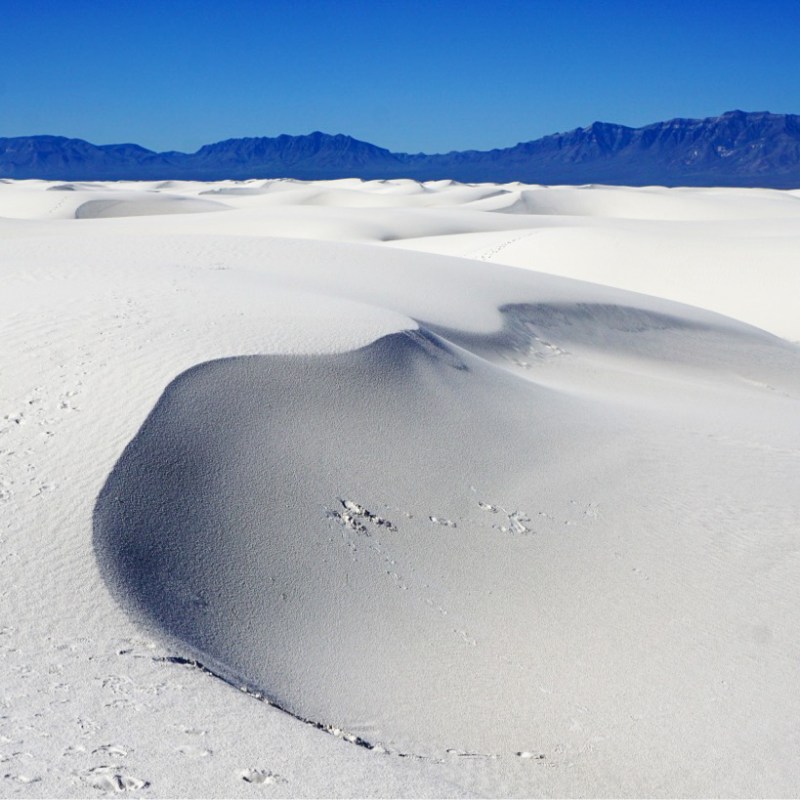
Cindy Barks
Editor’s Note: Formerly White Sands National Monument, White Sands was designated a U.S. national park on December 20, 2019.
Videos by TravelAwaits
Glistening white slopes extend as far as the eye can see. Black-diamond trails drift and shift with the wind. Cars inch forward on a hard-packed white surface.
A ski resort in the dead of winter? Hardly. Those white slopes are glistening with grains of sand, not snowflakes. The black-diamond signs refer to the difficulty of navigating gypsum dunes rather than groomed ski trails. And even though the road may look freshly plowed, it is packed sand, not snow, that forms the white surface.
White Sands National Park in southern New Mexico is surreal on a number of levels — not the least of which is its resemblance to a snowy winter wonderland.
Rest assured, though, that you won’t be experiencing sub-freezing temperatures on a trip to the scenic national park. Owing to its southern location near the United States-Mexico border, White Sands enjoys relatively mild weather year-round.
So, for a snowy-white adventure without the winter chill, head to White Sands for the perfect winter or spring getaway.
Here are seven things to know about the national park.

Cindy Barks
1. The Landscape Is Dreamlike
Even among the spectacular sand dunes of the Southwest, White Sands National Park stands out.
I love sand dunes, and I have driven hundreds of miles to take in dunes in California, Utah, and Colorado. I find them fascinating, with their fine beach-like sand so far from the ocean. Each of the dunes — whether it’s in the state park system of Utah or the national parks of California or Colorado — has its own unique features. I love the Coral Pink Sand Dunes of southern Utah, the desolate sand fields of California’s Death Valley, and the mammoth slopes of Colorado’s Great Sand Dunes.
But for me, none of them compares with the stark-white gypsum drifts of White Sands. Gazing out at the rolling dunes is an experience unlike any other. The white can be blinding in the sun, and the drifts conceal small basins filled with twisted trees and reddish reeds.
The national park bills itself as a place “like no place else on Earth,” and I have to agree. It is almost unfathomable that the dunes comprise 275 square miles of this remote section of New Mexico.

Cindy Barks
2. Sand Hiking Is Truly Unique
One of the main pleasures of a visit to White Sands is walking through the gypsum field. Just a short jaunt can get you into the midst of the dunes, with nothing but white sand and blue skies all around.
But be warned: Hiking in shifting sand is significantly more difficult than walking on solid dirt or rock. Add to that the somewhat disorienting nature of walking through all-white surroundings, and a hike at White Sands makes for a unique experience.
Fortunately, a number of trails of varying degrees of difficulty are available, allowing access for visitors of virtually any level of fitness and skill.
For those who want to experience the dunes via a hard, accessible surface, the national park offers the Interdune Trail, a 0.4-mile boardwalk with interpretive signs. The boardwalk is good for a taste of the dunes without the extreme conditions of some of the other trails. It requires about 20 minutes to complete.
The park’s two easy-to-moderate trails — the Playa Trail and Dune Life Nature Trail — offer a slightly more strenuous experience. The Playa Trail is a half-mile, while the Dune Life Nature Trail is about a mile. Both are family-friendly and fairly flat. The Playa Trail takes about a half-hour to complete, while the Dune Life Nature Trail takes about an hour.
For those up for longer walks through undulating terrain, White Sands offers the Backcountry Camping Trail and the Alkali Flat Trail. At 2 miles, the Backcountry Camping Trail traverses a variety of terrain and vegetation and requires hikers to climb fairly steep dunes through loose sand. It takes about 1.5 hours to complete.
For the most extreme experience, physically fit hikers who are up for an adventure should check out the Alkali Flat Trail. The national park’s website cautions, “This trail is not flat! You will be hiking up and down dunes the entire way.” At 5 miles, the trail takes hikers into lovely valleys and up steeply drifted ridges. There is no shade, water, or toilet facilities along the trail. The Alkali Flat Trail is best experienced in the cooler temperatures of late fall, winter, and early spring.

Cindy Barks
3. The Cool Look Can Be Deceiving
White Sands might look a bit frosty in photos, but don’t be fooled. The summer months can be brutally hot in southern New Mexico.
June, July, and August have average highs well into the 90s, and May and September’s highs hover in the high 80s. April and October tend to have the mildest weather, with average highs in the upper 70s, while March and November highs range from the high 60s to the low 70s.
Although nighttime lows in December, January, and February can reach the 20s and 30s, the daytime highs average in the upper 50s to low 60s. National Weather Service forecasts for the area can be found at noaa.gov.

Cindy Barks
4. You Can Go Sledding
Despite the mild temperatures, visitors looking for winter sports won’t be disappointed at White Sands. Sledding through the soft white sand is a popular activity for families.
The national park’s website notes that sand is not as slippery as snow, and sand sledding takes some practice. But with the right equipment — waxed plastic snow saucers are recommended — the gently sloping dunes make for a fun downhill glide.

Cindy Barks
5. It’s Off The Beaten Path
Located in South Central New Mexico, White Sands is a lengthy drive from most major cities. It is about 5 hours east of Tucson, Arizona; about 3.5 hours south of Albuquerque, New Mexico; and about 4 hours south of Santa Fe, New Mexico. The nearest major city is El Paso, Texas, about an hour and a half south of the national park.
The smaller New Mexico towns of Alamogordo and Las Cruces offer the nearest accommodations, and the closest airport is in El Paso, about 85 miles away.

Cindy Barks
6. Legends About The Site Abound
As the one-time stomping grounds of legendary gunfighter Billy the Kid, and as the purported home of a brokenhearted ghost wandering the dunes in her wedding gown, White Sands has its share of fables.
The national park’s website tells the story of William Henry McCarty, also known as Billy the Kid, who grew up rough in the area and ended up being accused of murdering the local sheriff. The notorious outlaw later escaped from a nearby courthouse, killing two deputies as he fled.
The link between the infamous Billy and the mysterious white dunes is undisputed.
“There is no doubt that [Billy the Kid] and other renowned characters of the time came across the largest gypsum dunefield as they traveled,” the site states.
The dunes also carry the legend of Pavla Blanca, a young woman named Manuela who is said to have followed her lover, Spanish explorer and conquistador Hernando de Luna, to New Mexico. As the legend goes, Manuela’s heart was broken when de Luna vanished somewhere in the ever-shifting gypsum of White Sands.
“It is believed that the ghost of Manuela still haunts the dunes of the great white sands, just after sunset, in her flowing white wedding gown, to seek her love, lost and buried beneath the eternal dunes,” says the website.

Cindy Barks
7. It Holds A Place In Military History
While White Sands was established as a national monument in the 1930s, its remoteness soon made it a logical location for military activity. Starting in 1942, just months after the bombing of Pearl Harbor in 1941, the U.S. Military established a permanent presence in the Tularosa Basin of the White Sands area, creating the Alamogordo Bombing and Gunnery Range, known today as the Holloman Air Force Base and White Sands Proving Grounds, now the White Sands Missile Range.
“Since the beginning, the operations of the monument’s military neighbors have been at the forefront of cutting-edge technology and experimentation,” says the White Sands website. “Visitors to the monument can experience a piece of this military history as the flight paths of fighter jets during mission training pass over the dunefield.”
As of July 1, 2020, all out-of-state visitors must quarantine 14 days or the duration of their trip — whichever is shortest. For the latest information about guidelines at the park, check out our full list of national parks requiring changes for visitors.
